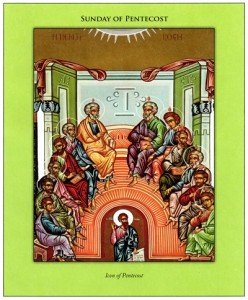Pentecost, which is the final event in the history of our salvation (for the gift of the Holy Spirit will not be followed, in this world, by any superior or new dispensation) leads us into the heart of the mystery of the Trinity – that ocean which is both the sourced and the end of the flood of divine love which carries men towards God.
 In order to mark this, the Eastern Church calls the time after this feast Weeks after Pentecost and designates Sundays as the last day of the week (You will recall that during the time after Easter Sundays are thought of as the first days of the week. On Mondays the Tone of the week changes to further highlight this reality). When the liturgical year starts (September 1st) there results from a curious split between the series of Sundays which belong in a certain way to Pentecost – to the time of fullness – and the feasts of Our Lord (i.e., Advent, Christmas and Theophany) – which are times of waiting, of birth and growth. In fact, during the first five or six months of the liturgical year, believers will know how, in their worship, to relate the Sundays, spiritually, with the mystery of Christ awaited, appearing, and growing in the midst of men. On the other hand, it is good that we should know how to maintain the Sundays from Pentecost till the end of the liturgical year in the framework of the time after Pentecost, or rather, the time of Pentecost, which will last right up to the beginning of September. All of these Sundays are celebrated in the spirit of Pentecost. At all the liturgies we hear episodes from the gospels which take place long before Pentecost, and belong to the earthly life of Jesus before His passion and glorification. We can interpret them in terms of the Spirit, for it is under the breath and through the power of the Holy Spirit that Jesus spoke and acted.
In order to mark this, the Eastern Church calls the time after this feast Weeks after Pentecost and designates Sundays as the last day of the week (You will recall that during the time after Easter Sundays are thought of as the first days of the week. On Mondays the Tone of the week changes to further highlight this reality). When the liturgical year starts (September 1st) there results from a curious split between the series of Sundays which belong in a certain way to Pentecost – to the time of fullness – and the feasts of Our Lord (i.e., Advent, Christmas and Theophany) – which are times of waiting, of birth and growth. In fact, during the first five or six months of the liturgical year, believers will know how, in their worship, to relate the Sundays, spiritually, with the mystery of Christ awaited, appearing, and growing in the midst of men. On the other hand, it is good that we should know how to maintain the Sundays from Pentecost till the end of the liturgical year in the framework of the time after Pentecost, or rather, the time of Pentecost, which will last right up to the beginning of September. All of these Sundays are celebrated in the spirit of Pentecost. At all the liturgies we hear episodes from the gospels which take place long before Pentecost, and belong to the earthly life of Jesus before His passion and glorification. We can interpret them in terms of the Spirit, for it is under the breath and through the power of the Holy Spirit that Jesus spoke and acted.
The theme of light is underlined in the Byzantine liturgical year. This divine light first appears with the birth of Christ; it grows with him; it triumphs on Easter over the darkness; and at Pentecost it reaches its full zenith. Pentecost is the midday flame. But this development, expressed during our liturgical year, must correspond to a growth in the inner light in our souls. The riches and symbolism of the liturgical year are worth nothing if they do not help this inner light to guide our lives.
Even the sequence of our liturgical year calls us to grow in our faith and our relationship with God.
Ask God to let your inner light grow!
